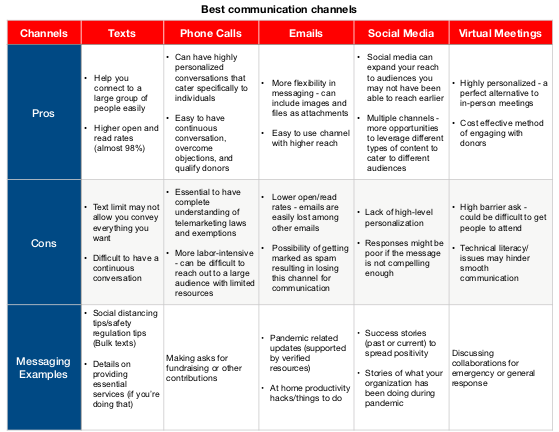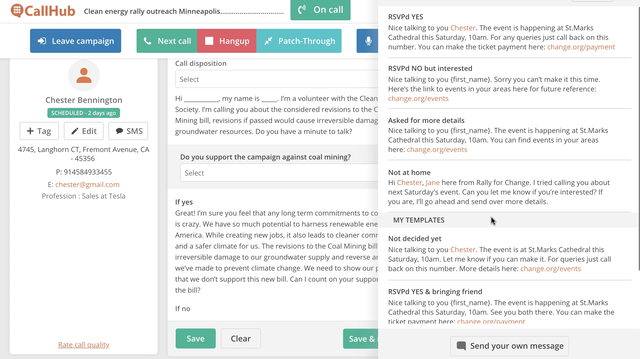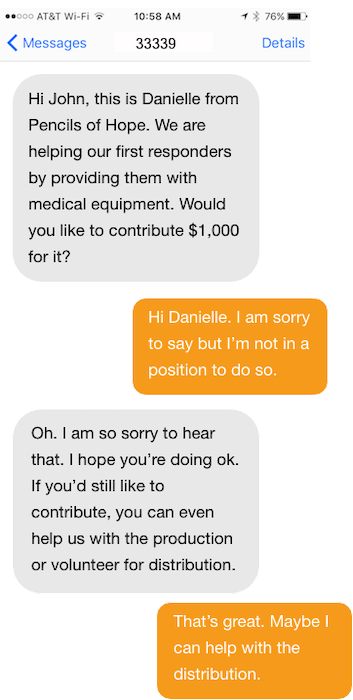Table of Contents
Right now, all communications need to be three things:
– Julia Campbell, Nonprofit influencer, Founder – JC Social Marketing
1. Clear
2. Concise
3. Compassionate
97% of nonprofits have been negatively impacted by the pandemic. Of this, 56.4% attribute their loss in donations to failing donor relations.
You can’t expect to maintain strong donor relationships with the same old strategies. With the changing lifestyle, the rules of engagement have also changed. It’s time to update!
In this post, we’ll go over the recommended communication channels during these times and how to choose the best one. Then, we’ll touch on some actionable tips to engage each donor segment, boost donor relations and thus improve your donor retention.
Best options for communications for donor relations
Donor communication is changing, and some choices of connecting with them (like in-person meets and events) are out. Now, organizations have to adopt communication channels that don’t compromise anyone’s health.
While there are many options available, the best fit will depend on three factors:
1. Efficiency in execution
How much time and effort does it take to communicate?
For example, connecting to one person over a call may take around 5 minutes. But, sending a text to 1000 people may take only a couple of minutes (if you already have the message ready). Hence, for a massive database, sending texts would be more efficient than making calls.
2. Message personalization
How personalized does the conversation have to be?
Based on the donor segment (major donors or small donors) and how likely they are to contribute, you will personalize your conversations.
A major donor typically needs extremely personal conversations – in this case, phone calls work well. Small donors need personalization too – but that can be delivered via texts or emails.
3. Available resources
How many people do you have to reach? (and how many volunteers do you have?)
You can make phone calls to 100 major donors if you have ten volunteers to help you out (each makes ten calls). However, for a donor database with 10,000 contacts (with ten volunteers), working on an email is more efficient.
Based on these factors, you can select a communication channel that fits the best:

Tips for maintaining donor relations with major donors
1. Check on them (and let them know what you’re doing)
Many of your major donors might be suffering from losses due to businesses slowing down or bearish markets. This is an excellent time to connect with these major donors and check in on them. Show them that you value them and don’t just care for their money.
It will help you:
- Build better donor relationships with them by showing them that you’re not just interested in their donations
- Understand them better which in turn helps you create a more personalized cultivation plan (after everything gets back to ‘normal’)
Getting in touch with a major donor will also allow you to talk about what your organization has been doing. These small steps then lead to better donor retention.
Recommended communication channels
- Phone calls (followed by a text) – Connecting with a major donor over a call shows that you value them (since you’re taking out the time to make a call). Moreover, you can send a follow-up text to ensure that they are aware of what you’re currently doing.
In platforms like CallHub, the follow-up texts can be easily combined with your calling campaign. You can send the text through your call center dashboard itself. Leave your contact details in the text too. In case they forward the message, people will know how to get in touch.

2. Virtual meetings – Virtual meetings put you face to face with donors, thereby feeling like an in-person meeting. They allow you to engage with donors better.
Remember to always segment donors by tagging them once you’ve achieved an important touchpoint. Sync this information in your donor database so your next conversation is up-to-date and personalized. Building relationships with donors is always about acknowledging their last update and keeping that in mind at the next touchpoint.
You May Also Like: Make Calls and Retain your Supporters
2. Send them a gift kit for better donor relations
Humans are an incredibly social species, and social distancing for long can be quite stressful.
“Apart from calls and virtual meets, gift-giving can help bridge some of these physical and emotional distances between people.”
Dr. Daniel Farrelly, psychology professor, University of Worcester.
Showing your appreciation with something tangible can be even more uplifting now. For your organization:
- A gift kit can serve as a constant reminder of your appreciation, something that cheered them during stressful times. This, in turn, develops a positive image of your organization among donors.
- Gifts like books, games, household essentials, etc. can also be incredibly useful for them. And useful gifts are not something they are likely to forget. This can position you on the top of their list of nonprofits to associate with when they are ready to do so again.
When sending gifts, it’s best to surprise them to maximize the impact. It shouldn’t feel like you’re sending a gift with a motive. If you’re planning to engage your major donor with gift kits, you can start with some fantastic ideas given in this post.
Recommended communication channels
- Emails – Make sure to inform donors that you will be sending them a gift. Since it isn’t anything urgent, you can drop them an email and let them see it whenever convenient.
- Text – Let the donors know where the package is and when it may arrive so they can plan for it. Given that people read text messages immediately, they are perfect for sending urgent updates in real-time.
You May Also Like: How to Improve Donor Relationships and Get Your Lapsed Donor to Donate Once Again
3. Ask for help (only if they can)
Even though it may seem unlikely, people still continue to donate. In times like these, major donors are a better chance of getting significant donations.
However, while making the ask, you have to ensure that you don’t come off as insensitive. Don’t can’t ask them to contribute to you if they are struggling themselves. They may react negatively to it and ultimately damage your reputation even after the crisis.
You can ensure this by
- Making an ask only after knowing that they are in a position to help you. You can get an understanding of this when you check in on them.
- Giving them multiple options to offer support. Major donors, too, may not be able to contribute as much as before. Hence, let them know the other ways they can contribute. Apart from lower bracket sponsorships, you can ask them to give in-kind, volunteer with you, spread the word about your efforts, etc.
When making the ask, make sure to tell them precisely how you plan to use the funds. Giving them a clear picture will elicit empathy rather than a negative emotional response.
Recommended communication channels
- Phone calls – Calling major donors is a great way to personalize your conversation and request. It also allows you to be completely transparent with your request, like in the example below:

2. Texts – Since it’s essential to personalize your requests, using P2P texting is a great choice too. It helps you reach out to a large group of major donors instantly while allowing them to have proper conversations with a human on the other end.

You May Also Like: 7 Donor Relations Strategies That Will Elevate Donor Engagement
Tips for maintaining donor relationships with corporates
4. Partner up to provide aid
During times of crisis, corporations step up to do their part in helping people too. But, often, these corporations may lack the plan or volunteers to reach out.
For example, Disney donated 150,000 ponchos for medical professionals to protect their clothing but lacked the manpower for distribution. So, they partnered with MedShare, who took the task of distributing them to hospitals where they were most needed.
Your organization can:
- Provide corporates with volunteers to help them reach out to people. This will be beneficial, especially if you’re not combating the pandemic. It’ll keep your volunteers busy (you’ll lose them to other organizations if they aren’t doing anything) while also establishing strong corporate donor relations.
- Leverage the corporation’s resources (warehouses for storage, communication software, etc.) to fuel your efforts to help people (or your cause). You would get easy access to resources while businesses get an excellent branding opportunity.
Recommended communication channels
- Phone calls – You can connect with the HR teams of organizations to discuss your proposition. Have a rough plan for collaboration with the business before calling.
- Texts – Send text blasts to people in your network, asking them to put in a word in their workplaces regarding the same.
- Emails – Apart from texts, you can also send an email blast to all your contacts. You’ll be able to provide more details in emails (since there are no text limitations).
5. Offer to help their employees
Several companies are struggling to stay afloat and provide for their employees. If you have an emergency fund to provide essential services, offer to help their employees. This could be by paying for their utility bills, salaries, meals, etc. It’s the perfect way to form a strong partnership.
While it will support the business, it will also streamline your efforts. Instead of having to search for people in need of assistance, you’ll know exactly where to focus your efforts.
Offering to support employees:
- Provides you with a new donor database (with brand new contacts and their basic information ready). This will be useful in spreading awareness about your organization (which will come in handy later when things get back to normal)
- Forge a strong relationship with the corporation. Aiding corporates in such a way is something they will never forget. It can lead to a great partnership beyond the crisis. Essentially, a strong relationship with a corporate can ease building donor relationships with their employees.
Recommended communication channels
- Phone calls – To establish such a partnership, you will first have to reach out to C-suites or HRs to discuss it. Connecting over a call is the best way to convey the idea.
- Texts – With high open rates, SMS broadcasts are the best way to inform employees about the aid you’re providing. You can also use texts to follow up on your conversation over the phone.
- Emails – Emails can be your first point of contact to warm up to your conversation before the call. You could also use it to give them the details in writing (to forward it to decision-makers) and to reach out to all the employees.
Read Next: Donation Incentives: The Right Way To Use Them, Raise More Money, and Improve Donor Retention.
Tips for maintaining donor relations with small donors
6. Offer insightful updates
The pandemic has a lot of unfiltered information spreading around that can cause panic. By combating misinformation, you can establish a reliable and trustworthy image for your brand.
Typically, you can focus on spreading news that can help people cope with the crisis better. This includes:
- Tips to remain safe and to ensure people don’t contract the disease. Steps to take if ill or symptoms to look out for are also useful.
- Hacks to remain productive with their time, efficiently go through their tasks each day, etc.
- Verified news about the pandemic, stats, updates, etc.
When circulating such information, support your thoughts with relevant resources (something like the WHOs reports for the updates).
Remember, the point here is to ensure that people believe in the information you provide among other dodgy sources.
Recommended communication channels
- Emails – To validate your information, you need the flexibility to add links, images, and files (like research papers) to your message. Emails give you that flexibility, apart from having a higher reach.
- Texts – Send SMS broadcasts with a headline and links to resources. To make the content more engaging, you could send MMS broadcasts too.
Moreover, you can also make these interactions more conversational with P2P texting. Promote your shortcode in the emails and bulk texts, encouraging people to inquire about the information from you. - Phone calls (IVR) – An interactive voice response system would also be perfect for relaying information to people. You can have a menu for the latest updates, one to leave questions (that you’ll respond to), etc.
7. Inform them about what you’re doing
While small donors may not be actively donating to your cause, they still care about it. But, if you don’t keep the conversation alive, they might forget about your organization. This will hamper your donor retention and make it hard for you to get them back when things go back to normal.
To avoid this, engage your small donors by giving them updates on:
- If the organization is changing its focus temporarily (to combat the pandemic) or continuing to work for the same cause.
- How you are dealing with crisis management or whether you have emergency funds
- If something is lacking in your efforts and how others could help you out
Keeping these donors in the loop will ensure that you don’t lose touch with them. Plus, it’s a subtle way to ask for their help too.
Recommended communication channels
- Social Media – Social media gives you the flexibility to communicate your information creatively. Plus, you can reach a wider audience.
- Email – Emails are the most cost-effective way to convey information to an extensive database. They also allow you to craft the information creatively (with graphics and visuals) too.
8. Offer help
While checking up on donors, you may come across a lot of donors in need. If you can, this is the right time to support them, especially if you’re providing essential services. If they need help, they are most likely unable to donate. However, maintaining those donor relations in their time of need can boost donor retention for you in the future.
This can help you:
- Strengthen donor relations by showing them that you’re there to support them, too, when needed.
- Reinforce your organization’s credibility. Now they know they can trust you when you claim to help people in need.
Recommended communication channels
- Social Media – The word of mouth factor comes into play on social media. It can expand your reach exponentially. If your donors don’t take your help, they might still share the information, thereby spreading awareness about your organization.
- Text – While social media can get you in front of new people, SMS broadcasts will get you better penetration into your current audience (given the open rate). Texts can prove to be an incredible channel to reinforce your message.
Bonus tips for donor relations and improved donor retention
Everything we spoke about earlier helps you improve donor relations with specific donor segments. However, there are a few tips that you can use to engage with all donors alike.
9. Thank everyone
Amidst the chaos, receiving a thank you message would be incredibly heartening. Appreciating your donors even when they are not helping you forms the foundation of a healthy relationship.
Take this opportunity to strengthen this foundation by:
- Thanking everyone for their contributions in the past. Remind them of what you achieved earlier when times were better.
- Highlighting personal stories of the beneficiaries and letting donors know that good things happen to good people
To communicate your appreciation, emails, texts, and phone calls are the go-to channels. Segment donors based on their preferred channels and use those to distribute your updates. Your donor database should include this information, along with other data points, about each contact.
10. Spread some positive news
Good news can be the ray of hope during these testing times. You can leverage this to trigger positive emotions in your donors.
If people relate your brand to a positive feeling, their likelihood of associating with you increases. This can make your nonprofit fundraising efforts incredibly easy in the future. Aim to:
- Spread some positive information from around the world, success stories, etc.
- You could also send out something to lighten their moods like humorous clips, memes, or heartwarming stories.
Email, social media, and texts are the best channels to reach out to people with such news.
To conclude
To maintain strong donor relations, you have to change your donor communication. Now, more than ever is the time to practice Julia Campbell’s three C’s of nonprofit communication.
Hopefully, these tips help you adapt your communication strategies to these strange times.

